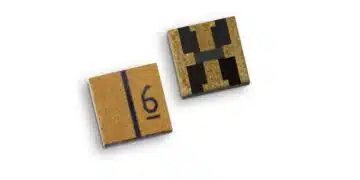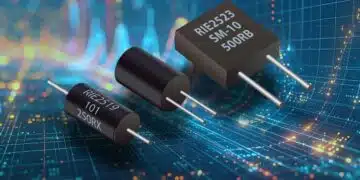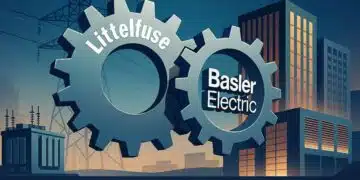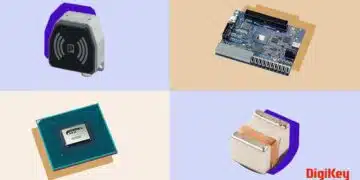Traditionally, designers of high reliability aerospace and military electronic systems depended on military established reliability (MIL-ER) capacitors because of their quantified reliability and stable construction.
The cost of military qualified components is usually high because of the test cycles and qualification processes they go through before they are approved. Global economic pressures have forced governments to decrease military budget and revise their armament projects. This reduction of military budget has resulted in increased use of commercial off-the-shelf (COTS) components for military and aerospace applications that are not mission critical.
In a nutshell, a Commercial-Off-The-Shelf capacitor is a device produced using the same materials and processes as a standard commercial grade product that is then “up-screened” using Mil-Spec drawings to provide a high reliability component.
Although commercial-off-the-shelf grade capacitors are cost effective and readily available, they provide the high reliability demanded by most aerospace and military applications. Furthermore, using COTS enables electronic systems designers to produce small and light-weight electronic assemblies. This makes COTS an attractive option for many applications that demand highly reliable components. Apart from military applications, designers are also using commercial-off-the-shelf grade capacitors for other high reliability applications such as space/satellite, industrial, medical, and telecommunication applications. However, unlike military qualified capacitors, COTS are not suitable for applications that demand fully compliant military-grade parts.
Commercial-Off-The-Shelf Multilayer Ceramic Capacitors
Multilayer ceramic capacitors are used in a broad spectrum of electronic systems including telecommunication, medical, and automotive systems. The use of MLCCs in military and aerospace systems is mainly due to their high reliability. Commercial-off-the-shelf multilayer ceramic capacitors have been evolving to meet the growing demand for miniature components with high volumetric efficiency and high performance. Commercial-off-the-shelf multilayer ceramic capacitors are available in a wide range of capacitances and voltage ratings to accommodate the diverse needs of today’s electronic systems.
Manufacturers of commercial-off-the-shelf MLCCs have been reducing the thickness of the dielectric material to create space for more dielectric layers/electrodes. Most suppliers have also switched to Base Metal Electrode (BME) technology in order to cut the cost of producing capacitors. Compared to Precious Metal Electrode (PME) technology, BME technology allows production of COTS multilayer ceramic capacitors at a lower cost. BME technology is mainly used when smaller and lighter Hi-Rel designs are desired. The technology is also used to produce COTS capacitors with lower voltage ratings.
Some applications subject electronic systems to extreme operating conditions and demand components that are optimized to withstand harsher environments. Ruggedized commercial-off-the-shelf multilayer ceramic capacitors are suitable for electronic systems that are likely to be exposed to high humidity or extreme shock and vibration. In most cases, commercial-off-the-shelf capacitors intended for such applications are expected to meet specific requirements. These COTS MLCCs are widely used by designers of aerospace and military systems as alternatives to expensive full mil-spec parts.
Commercial-off-the-shelf MLCCs for applications that demand a higher level of reliability are tested and screened to ensure that they are suitable for the specific applications. The type of qualification tests and screening methods greatly determine the cost of COTS multilayer ceramic capacitors. The cost can be considerably high if the customer requires the capacitors to be subjected to MIL-type qualification tests and screening methods.
Commercial-Off-The-Shelf Tantalum Capacitors
Tantalum capacitors have low equivalent series resistance (ESR), low equivalent series inductance, high volumetric efficiency, high stability, and high reliability. The impressive stability and reliability of tantalum capacitors make them a suitable choice for a broad range of high reliability applications such as aerospace, medical, and military systems. Nevertheless, these capacitors have been facing stiff competition from ceramic and aluminum capacitors.
To produce high reliability specialty-type tantalum capacitors, manufacturers employ high performance technologies and enhanced manufacturing processes. This approach has enabled them to produce tantalum capacitors that are capable of delivering ultra-low equivalent series resistance, wider operating temperature ranges, higher capacitance per voltage values, and higher voltage ratings. These hi-rel capacitors are subjected to different screening and qualification tests depending on the applications that they intended for. Commercial-off-the-shelf tantalum capacitors are usually subjected to a lower level screening method compared to military established reliability (MIL-ER) grade capacitors.
Most tantalum capacitors use manganese dioxide electrolyte. As the demand for low ESR tantalum capacitors continues to grow, manufacturers are increasingly switching to other materials such as high-conductivity polymers. Compared to manganese dioxide, conductive polymers have better electrical conductivity. Nevertheless, the high reliability of manganese dioxide electrolyte makes it a popular choice for high reliability COTS tantalum capacitors.
Although most commercial-off-the-shelf tantalum capacitors are not designed to operate at temperatures above 125degC, some high reliability applications such as oil exploration systems and automotive systems demand a higher maximum operating temperature. If conventional technology is used, extending the temperature rating of tantalum capacitors can affect characteristics such as capacitance, dissipation factor, and DC leakage. Manufacturers are using the latest technology advances to produce tantalum capacitors with maximum operating temperatures of above 125degC. High temperature COTS tantalum capacitors are suitable for a broad range of applications including on-engine and under-the-hood automotive applications as well as aerospace and defence systems. These commercial-off-the-shelf capacitors provide designers of electronic systems with a cost effective option for applications that demand high temperature components.
Most high reliability tantalum capacitors are available for working voltages of up to 125V. If conventional technology is used to extend the working voltage of these capacitors, crystallization of the amorphous dielectric is likely to occur. To produce tantalum capacitors with higher voltage ratings, manufacturers employ advanced technology to suppress crystallization.
Some manufacturers provide commercial-off-the-shelf tantalum capacitors that meet various military and aerospace standards. In addition, some components incorporate customizable screening and testing protocols and are suitable for a broad array of high reliability military and aerospace applications.
Conclusion
Commercial-off-the-shelf grade capacitors have evolved tremendously in performance and reliability, and this has made them an attractive cost-effective option for high reliability applications. The high performance, reliability, and availability of these capacitors enable designers of aerospace and military electronic systems to produce high-reliability systems at a lower cost. Unlike military grade capacitors, COTS grade capacitors are available in a wide range of sizes and capacitances. Nevertheless, commercial-off-the-shelf grade capacitors are not suitable for mission critical applications. Such applications demand military qualified established reliability (MIL-ER) grade capacitors.
featured image source: AVX































